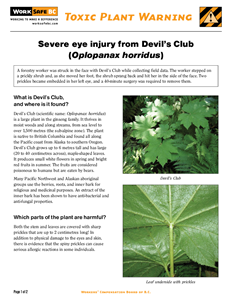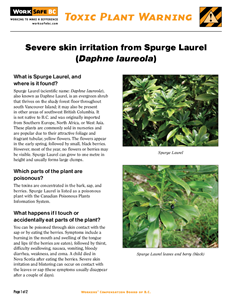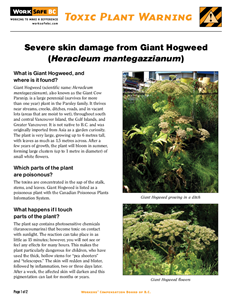Toxic plants
If you work outdoors and come into contact with a toxic or hazardous plant, you can suffer serious health effects. These include injury, chemical burns, and poisoning. To protect yourself, get to know which plants are a potential hazard in your workplace.
- How workers are exposed
- The risks
- How to reduce the risks
- Resources
How workers are exposed
Landscapers, gardeners, silviculturists, and others who work outdoors come into contact with a variety of plants. Some of those plants can be harmful if touched.
Some examples of hazardous plants in B.C. are:
- Devil's club
- Giant hogweed
- Spurge laurel
The risks
The three most common injuries when working with toxic and hazardous plants are:
| Physical injuries |
|
| Chemical burns |
|
| Poisoning |
|
How to reduce the risks
Some non-toxic plants can cause serious injury with their thorns or spines. Employers should give workers information on how to identify hazardous or toxic plants.
The best way to reduce the risk of exposure to hazardous or toxic plants is to avoid them. If that's not possible, there are other risk controls to use. When choosing risk controls, start by asking the questions in the following steps, which are listed in order of effectiveness.
-
1
Engineering controls
Making physical modifications to facilities, equipment and processes can reduce exposure. A question to consider:
- Can equipment and tools be used to reduce physical contact with plants (e.g., during their removal)?
-
2
Administrative controls
These involve changing work practices and work policies. Providing awareness tools and training also count as administrative controls. All can limit the risk of hazardous or toxic plant exposure. Some questions to consider:
- Can warning signs be posted to warn unprotected workers where these plants are located?
- Have you developed safe work procedures for working around or removing these plants?
- How will you train your workers regarding the hazards of these plants and how to protect themselves?
- Do you have adequate first aid supplies on hand?
-
3
Personal protective equipment
This is the least effective control. When used, there must always be at least one other control in place as well. Some questions to consider:
- Do workers have the proper eye wear and protective clothing for use during the handling or cleanup of toxic plants?
- Has personal protective equipment been checked to make sure it is working properly?




